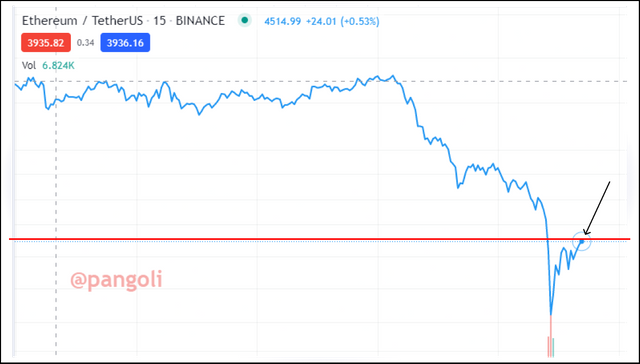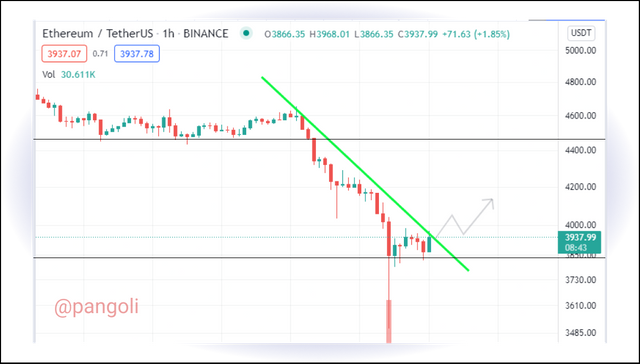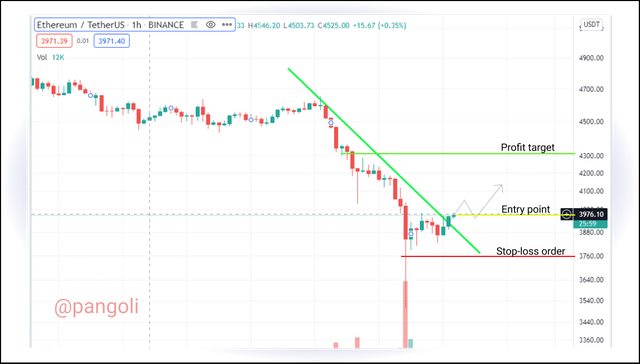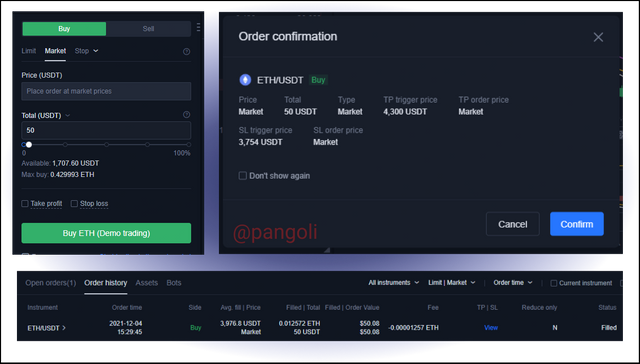Understanding Trends II - Crypto Academy - S5W3 - Homework Post for @reminiscence01

Image source
Hello everyone...
I'm glad to be among the participants of this week's lecture with professor @reminiscence01. It was yet another exposure to the world of market trends. I learnt a lot, and have applied that knowledge to solve the homework tasks below.
Q1 a) Explain your Understanding of Trend Reversal. What is the benefit of identifying reversal patterns in the Market?
The price action of assets in the financial markets is known to be in one of two states at any point in time. They are either Trending- when the price moves consistently in an upward or downward direction, or Ranging - when the price is not moving in a clear direction but stretches sideways, bouncing around in what looks like a horizontal tunnel.
Most of the time, traders would prefer a trending market to a ranging market because the volatility present in a trending market saturates it with opportunities that traders can benefit from. These opportunities can show up as a trend is set to begin, taking a pause to continue, or reversing to establish a new trend in a different direction.
For any of the market situations listed above to occur, the price action gives off signals through unique candlestick patterns and/or structures that can provide useful insights to traders as regards what direction the market will go next.
A set of these unique candlestick patterns are collectively called reversal patterns. As the name implies, reversal patterns come up when a particular market trend is overstretched and due for a change. They signify trend exhaustion, and what usually follows after a typical reversal pattern is that the price action would switch into another direction.
Some popular reversal patterns in financial market trading include: heads and shoulders, double top, double bottom, etc.
b) How can a fake reversal signal be avoided in the market? (Screenshot needed).
It is always advised that traders should follow the market meticulously. Since the financial market is a volatile one riddled with lots of human emotions in response to price action, it is not uncommon to see signals that do not play out as they are supposed to.

Image source
Sometimes, there could be an obvious reversal pattern printed boldly on the price chart and the market does the exact opposite of what the pattern suggested. At this point, traders who had jumped in using the signal from the failed signal end up bearing avoidable losses. These fake signals are often referred to as Fake-outs.
In order to avoid fake market signals, it is always safe to do analysis across multiple timeframes, as well as verify signals with other indicators. To get more accurate results from indicators,
Q2 a) Break of market structure
The market always move with a structure that guides its overall direction at any point. This structure helps traders to filter out minor price movements from the major ones and gives a macro view of what is going on in the market.

Image source
For an uptrend, the market structure comprises a series of Higher Highs (HH) and Higher Lows (HL) that appear consecutively. Once the consistency of this structure is violated, the market structure is said to have been broken. Thus, leaving room for a possible trend reversal to occur.
When the market is in a downtrend, the market structure would also reveal a series of Lower Highs (LH) and Lower Lows (LL). A break of this structure would mean that a Higher Low (HL) or Higher High (HH) comes up after a sustained streak of Lower Lows and Lower Highs.
b) Break of Trendline
A break of trendline has some form of similarity with a break of market structure. A trendline is a simple straight line drawn across the extreme points of a market trend.
Trendlines are oftentimes regarded as dynamic support or resistance points because the price action bounces off the line to maintain the current trend, or breaks through it to establish a new one.

Image source
In a case where the market is in an uptrend, the trendline is usually a dynamic support line drawn across respective Higher Lows (HL). At any point where the price action makes a Lower High, leading to a bearish candle closing below the bullish trendline. It is said here that the trendline is broken and a reversal is imminent.

Image source
The reverse applies when the market is in a downtrend. The trendline here becomes a dynamic resistance point drawn above the respective Lower Highs (LH). Also, the trendline here gets broken when the price forms a Higher High, and is sustained until a bullish candlestick closes above the trend line. When such breakouts happen, it is believed that the market would reverse to establish a new trend in the direction of the breakout.
c) Divergence
A divergence is said to exist in the market when there is no confluence between price action and a price oscillator. Price oscillators are often leading indicators that closely mirror price action at any given point in time.
A typical divergence will always have the price action and the price indicator saying different things at the same point.

Image source
For instance, in an uptrend, the price action might be pushing to higher highs when it has been reflected on the indicator window that an asset is already overbought and heading downwards.
When this occurs, the trader should observe the price action more closely as the current trend might not be sustainable. The price might revert sharply into the direction suggested by the oscillator.

Image source
Conversely, in a downtrend, a divergence occurs when price action makes lower lows while the price oscillator is making higher highs. Since oscillators are leading indicators, a divergence might signify exhaustion of the current market trend. Hence, it is believed that the price action, with time, would readjust to align with the indicator.
d) Double top and Double bottom
These are very popular reversal patterns that apply to bullish and bearish market situations, respectively. They derive their meaning from the prevailing market structure and are visible at any point they appear.
The Double top pattern often appears at the cusp of an uptrend to signal a possible trend reversal into a downtrend. For this pattern to be validated, the price action must establish two peaks at about the same level, with a minor retracement between the two peaks.

Image source
After the completion of the second peak, if the price breaks through the support line at the low point of the retracement between the peaks, it is believed that the market structure has been violated in favor of a bearish reversal.
On the other hand, the double bottom is a bearish-bullish reversal pattern that mostly appears at the floor of a downtrend. This pattern is said to be complete when the price action establishes two bottoms at about the same level, with a minor upward movement separating the two bottoms.

Image source
Also, if the price breaks through the resistance l line at the highest point of the retracement between the two floors, it is believed that the market structure has been violated in favor of a bullish reversal.
Q3: Practical Illustration with Demo trade
For my illustration, I used the ETH/USDT pair. My analysis were done using the 1 hour time frame.

Image source
From the line graph above, it can be observed the the ETH/USDT pair has just made an attempt to break out of a downtrend.

Image source
I drew a trendline across the previous lower highs on the candlestick chart. From here, it is evident that price action is approaching the trendline from below in a bid to breakout into an uptrend. I waited to see if the trade would go as I have suspected.

Image source
As expected, the price action broke through the trendline in a bullish momentum and closed above the trendline. From here, I proceeded to define my entry point at the beginning of the next bullish candle.

Image source
Having defined my entry points and targets, I proceeded to place my trade using a Demo account. Screenshots of my trade are included above.
Conclusion
A proper understanding of technical tools could be the game changer for many traders out there. With sufficient interaction and practice with these tools, traders stand a better chance to have a deeper knowledge of how they can be effectively applied to different market situations. Thus, setting themselves up for a profitable ride in the market when opportunities present themselves.
Thank you for reading...
CC:-
@reminiscence01
Hello @pangoli , I’m glad you participated in the 3rd week Season 5 of the Beginner’s class at the Steemit Crypto Academy. Your grades in this task are as follows:
Observations:
This is not a clear double top formation. Improve your chart analysis.
Recommendation / Feedback:
Thank you for participating in this homework task.